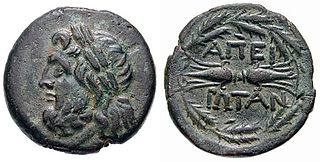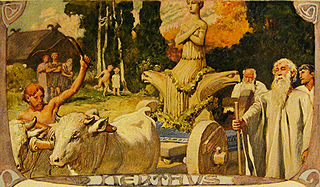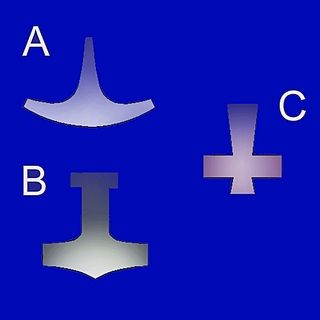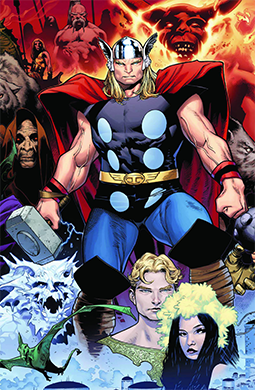
Ukko, Äijä or Äijö, parallel to Uku in Estonian mythology, is the god of the sky, weather, harvest, and thunder across Finnic paganism.

A thunderbolt or lightning bolt is a symbolic representation of lightning when accompanied by a loud thunderclap. In Indo-European mythology, the thunderbolt was identified with the 'Sky Father'; this association is also found in later Hellenic representations of Zeus and Vedic descriptions of the vajra wielded by the god Indra. It may have been a symbol of cosmic order, as expressed in the fragment from Heraclitus describing "the Thunderbolt that steers the course of all things".

Mjölnir is the hammer of the thunder god Thor in Norse mythology, used both as a devastating weapon and as a divine instrument to provide blessings. The hammer is attested in numerous sources, including the 11th century runic Kvinneby amulet, the Poetic Edda, a collection of eddic poetry compiled in the 13th century, and the Prose Edda, a collection of prose and poetry compiled in the 13th century. The hammer was commonly worn as a pendant during the Viking Age in the Scandinavian cultural sphere, and Thor and his hammer occur depicted on a variety of objects from the archaeological record. Today the symbol appears in a wide variety of media and is again worn as a pendant by various groups, including adherents of modern Heathenry.
Thor, the god of Norse mythology, has appeared as a character in various comics over the years, appearing in series from a range of publishers.

Thor is a prominent god in Germanic paganism. In Norse mythology, he is a hammer-wielding god associated with lightning, thunder, storms, sacred groves and trees, strength, the protection of humankind, hallowing, and fertility. Besides Old Norse Þórr, the deity occurs in Old English as Thunor, in Old Frisian as Thuner, in Old Saxon as Thunar, and in Old High German as Donar, all ultimately stemming from the Proto-Germanic theonym *Þun(a)raz, meaning 'Thunder'.

Germanic mythology consists of the body of myths native to the Germanic peoples, including Norse mythology, Anglo-Saxon mythology, and Continental Germanic mythology. It was a key element of Germanic paganism.

Perkūnas was the common Baltic god of thunder, and the second most important deity in the Baltic pantheon after Dievas. In both Lithuanian and Latvian mythology, he is documented as the god of sky, thunder, lightning, storms, rain, fire, war, law, order, fertility, mountains, and oak trees.

Ukonvasara, or Ukonkirves, is the symbol and magical weapon of the Finnish thunder god Ukko, similar to Thor's Mjölnir. Ukonvasara means 'hammer of Ukko'; similarly, Ukonkirves means 'axe of Ukko'. It was said that Ukko created lightning with Ukonvasara.
The Norse mythology, preserved ancient Icelandic texts such as the Poetic Edda, the Prose Edda, and other lays and sagas, was little known outside Scandinavia until the 19th century. With the widespread publication of Norse myths and legends at this time, references to the Norse gods and heroes spread into European literary culture, especially in Scandinavia, Germany, and Britain. In the later 20th century, references to Norse mythology became common in science fiction and fantasy literature, role-playing games, and eventually other cultural products such as Japanese animation. Storytelling was an important aspect of Norse mythology and centuries later, with the rediscovery of the myth, Norse mythology once again relies on the impacts of storytelling to spread its agenda.
*Perkʷūnos is the reconstructed name of the weather god in Proto-Indo-European mythology. The deity was connected with fructifying rains, and his name was probably invoked in times of drought. In a widespread Indo-European myth, the thunder-deity fights a multi-headed water-serpent during an epic battle in order to release torrents of water that had previously been pent up. The name of his weapon, *mel-d-(n)-, which denoted both "lightning" and "hammer", can be reconstructed from the attested traditions.

As polytheistic systems evolve, there is a tendency for one deity to achieve preeminence as king of the gods. This tendency can parallel the growth of hierarchical systems of political power in which a monarch eventually comes to assume ultimate authority for human affairs. Other gods come to serve in a Divine Council or pantheon; such subsidiary courtier-deities are usually linked by family ties from the union of a single husband or wife, or else from an androgynous divinity who is responsible for the creation.

The sky often has important religious significance. Many religions, both polytheistic and monotheistic, have deities associated with the sky.

Pantheon High is an original English-language manga written by Paul Benjamin and illustrated by Steven Cummings, with inking by Cummings' wife, Megumi. It is published in the United States and United Kingdom by Tokyopop.

A weather god or goddess, also frequently known as a storm god or goddess, is a deity in mythology associated with weather phenomena such as thunder, snow, lightning, rain, wind, storms, tornadoes, and hurricanes. Should they only be in charge of one feature of a storm, they will be called after that attribute, such as a rain god or a lightning/thunder god. This singular attribute might then be emphasized more than the generic, all-encompassing term "storm god", though with thunder/lightning gods, the two terms seem interchangeable. They feature commonly in polytheistic religions, especially in Proto-Indo-European ones.

Thor Odinson is a superhero appearing in American comic books published by Marvel Comics, based on the Norse Mythology god, Thor (Þór). Created by artist Jack Kirby, writer Stan Lee, and scripter Larry Lieber, the character first appeared in Journey into Mystery #83 (1962) and first received his own title with Thor #126 (1966). Thor is an adaptation of the deity of the same name from Norse mythology, and many aspects of Thor's character are based on his mythological counterpart. Comic books featuring Thor have been published across several volumes since the character's introduction.
Inca mythology is the universe of legends and collective memory of the Inca civilization, which took place in the current territories of Colombia, Ecuador, Peru, Bolivia, Chile, and Argentina, incorporating in the first instance, systematically, the territories of the central highlands of Peru to the north.
In Slavic mythology, Perun is the highest god of the pantheon and the god of sky, thunder, lightning, storms, rain, law, war, fertility and oak trees. His other attributes were fire, mountains, wind, iris, eagle, firmament, horses and carts, and weapons. The supreme god in the Kievan Rus' during the 9th-10th centuries, Perun was first associated with weapons made of stone and later with those of metal.
Astrape and Bronte are, in Greek mythology, the goddesses of lightning and thunder. As members of Zeus' entourage, they were his shield bearers, given the task of carrying his thunderbolts along with Pegasus.

Mjölnir and Stormbreaker, in the Marvel Cinematic Universe (MCU), are sentient enchanted weapons of choice used by Thor. Both are melee weapons and were created out of Uru metal forged with the heat of a dying star in the Dwarven kingdom of Nidavellir, with the assistance of the dwarf king and master weapon-maker Eitri. Mjolnir is a hammer, and was enchanted by Thor's father, Odin, so that only those the hammer deemed "worthy" are capable of wielding or even lifting it. Stormbreaker is an axe, and although it does not have such a worthiness enchantment, its power is such that a mere mortal attempting to wield it would be driven mad.












